
All the crossings have one thing in common... Great BIG Trains!
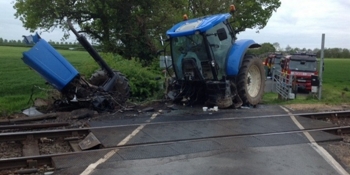 Trains travel at high speed and often weigh hundreds of tons. Cars weigh between 1 and 2.5 tons. Trains always win in fights with cars!
Trains travel at high speed and often weigh hundreds of tons. Cars weigh between 1 and 2.5 tons. Trains always win in fights with cars!
The image shows a tractor hit by a slow train on a crossing with no gates. Tractors are much tougher than cars - looking at this picture, it's not hard to imagine what a fast train might do to a car.
Keep yourself safe by looking out for warning signs; these will give information about the type of crossing to expect.
Use your hazard routine as you approach crossings and stop when the lights show. There may also be bells or sirens - if you hear these, prepare to stop.
 Some crossings have barriers, some have gates, some are open, however, they all require the same careful and cautious approach.
Some crossings have barriers, some have gates, some are open, however, they all require the same careful and cautious approach.
Some crossings have barriers, some have gates, and some are open. However, they all require the same careful approach.
While accidents at railway crossings are rare, the consequences are severe - the picture shows what happened when a truck met a train at a rail crossing - imagine what would happen to a car!
Treat crossings with respect!
This video shows a 'half-barrier' crossing.
Half-barrier crossings are being phased out in the UK, but figures from 2019 showed that although only 6% of crossings were the 'half-barrier' type, they represented 32% of the accident risk recorded at all UK crossings. The general principles shown in the video are the same for all crossings.
You can see more roundabout videos in the Driving Test Success practical driving app. (Google Play | App Store - appstore practical videos available as an in app purchase in the 4 in 1 kit)
Not many test routes include railway crossings, however, if you come to a crossing during your test you will be expected to deal with it in a safe and appropriate way, just as with any other hazard.
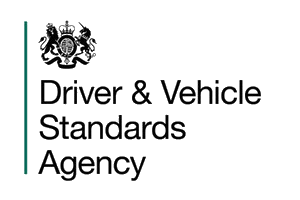
The examiner will want to see:
Use of your hazard routine
Appropriate speed when approaching
Appropriate speed when driving across the tracks
Correct action on signs lights and barriers controlling the crossing

Approaching railway crossings is much the same as approaching pedestrian crossings. And you will also be looking out for pedestrians as well as trains.
The reason for being cautious about pedestrians is that crossings do not always have a clearly defined footpath. There is also the possibility that pedestrians might trip on an uneven surface or the railway track itself.
Sometimes you will have a clear view of a crossing as you approach, alternatively, your first warning might be a road sign indicating a crossing ahead.
Concealed crossings will often have countdown markers on the approach. These are white with red countdown bars, each representing 100 yards (shown below).
Check your mirrors and be prepared to reduce speed on approach; you must be able to stop if the lights show. If there are no lights or barriers, you must be able to stop at the Give Way/Stop line if there is a train approaching. Do not overtake other vehicles on the approach to crossings, even if you think they are slowing or stopping needlessly - they might have seen something you missed.
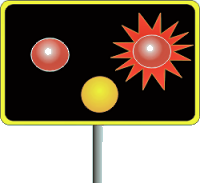 Most crossings have lights. The single steady amber has the same meaning as an amber at a standard set of traffic lights; it means stop behind the stop line unless it would be dangerous. After the amber light, there are twin flashing red lights - these mean STOP.
Most crossings have lights. The single steady amber has the same meaning as an amber at a standard set of traffic lights; it means stop behind the stop line unless it would be dangerous. After the amber light, there are twin flashing red lights - these mean STOP.
The warning signs below indicate whether or not the crossing has gates (including barriers). There is also a warning sign for a risk of 'grounding' - although the risk of grounding will mainly affect long vehicles, it does warn you that the crossing may be uneven or humped. Beware of overhead cables if you ever drive a lorry or other high vehicle across a crossing.
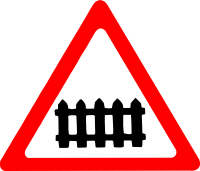
Crossing with gates

Crossing with no gates
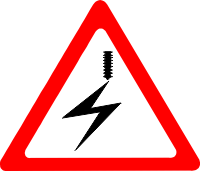
Overhead cables

Uneven crossing
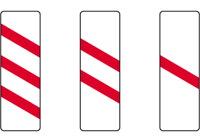
Countdown markers used on approach to some railway crossings
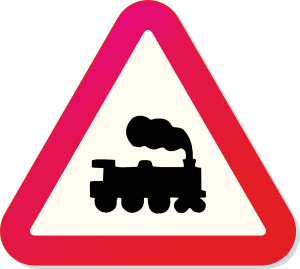
You will find rail crossings with no gates or barriers on some very quiet roads or tracks. Some of these will have no lights or warning sirens. They will usually have Give Way or Stop signs.
These crossings call for extreme caution.
Make sure that the line is clear before driving across. This might mean you have to get out of the car to look up and down the line if the view is restricted.
Open your car windows so that you can hear approaching trains. If you have a passenger, it's a good idea for them to get out to watch the line and wave you across when it is clear.
The basic rule at these crossings is STOP, LOOK and LISTEN.
If a train is approaching, do not drive across - even if you think the train is far enough away. Trains can travel very fast, but unlike road vehicles, they can't stop quickly.
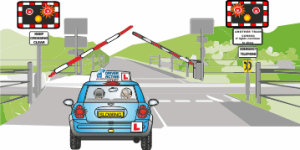 At half-barrier crossings, the barriers block off each side of the road separately (shown in the picture).
At half-barrier crossings, the barriers block off each side of the road separately (shown in the picture).
There are warning lights, audible alarms and warning signs. At this type of crossing, the train triggers the lights and barriers approximately 30 seconds before its arrival, leaving very little time for mistakes.
The barriers block the entrance to the crossing but leave the exit clear, enabling any driver who has already crossed the white stop line to continue when the barriers come down.
Guidelines for crossing safety
Take care as you approach the crossing, and be ready to stop
Never overtake on the approach to the crossing
Never try to 'beat' the crossing - always stop if a light shows
You must stop behind the white line when the amber light is on, or the red lights are flashing
Do not drive onto the crossing unless your exit is clear and there is sufficient room to drive across and clear the crossing
If you cross the white line as the amber light comes on, keep going
Never reverse onto or over the level crossing
If the red lights keep flashing after a train has passed, wait – another train is coming
Never zig-zag around the barriers – only cross when the barriers are fully raised and the lights go off
Half-barrier crossings are rare these days. They are being phased out because they present a danger of death and serious injury when drivers do not follow the rules.

Full barriers usually operate the same way as half barriers, but the barriers block off the whole road. At other crossings, full width automatic gates are used instead of barriers.
These crossings have a few different formats, but all require you to follow the basic rules of stopping when the lights show (as shown in the half-barrier guidelines).
There are still some crossings with manual gates or gates operated by an attendant. If you come across an unattended crossing with gates, there will be a warning sign and instructions. Follow the instructions carefully, ensuring the line is clear before driving across.
The 'gate' sign indicates that the crossing has either full or half barriers or gates.
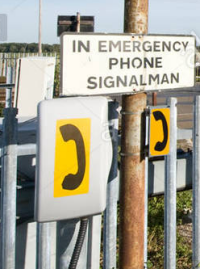
If you break down at a railway crossing, your first priority must always be the safety of yourself, your passengers and anyone else who might be around. Saving your car is the least important thing!
You can avoid breaking down or getting stuck on a crossing by always keeping the crossing area clear. If there is a traffic queue, do not drive onto the crossing area unless you have enough room to drive off at the other side (many crossings will have 'Keep Clear' or 'yellow box' markings).
By allowing a clear space on the other side of the crossing, you are likely to have enough momentum to 'roll forwards' off the crossing in the event of a mechanical problem.
The following rules will help to keep you safe
Get your passengers out of the car and away from the crossing straight away. It is vital that you do this before doing anything else. Don't wait until the lights start to flash or the barriers come down; this may lead to panic.
If there is a telephone at the side of the crossing, use it to contact the signal operator. Explain the problem so that the operator can try to stop approaching trains - there is no guarantee they can do this - an express train travelling at full speed can take over three-and-a-half miles to stop..
If there is enough time, move the vehicle from the crossing. Make sure that your parking brake is released, and try to push your car clear.
In an electric car you might be able to push the car clear, although there might be some resistance from the motors - if possible, select neutral before trying to push it clear. Neutral is provided to enable pushing and towing. However, the procedure for selecting neutral varies from vehicle to vehicle and it might not be as straightforward as in a manual or automatic car.
In an automatic, CVT automatic, hybrid or manual car select neutral to enable you to push the car clear.
In a manual car you might be able to 'jerk' the car forwards using the starter motor. To do this, select third gear, and, with the clutch engaged (pedal up) turn the ignition key (and hod it) to activate the starter motor.
After moving your car, phone the signal operator again to inform him that the crossing is clear. If you cannot move your car, use the phone to ask for further advice.
If the bells ring, or you see a train approaching, you must leave your car and stand well clear of the crossing.
 Railway crossings Quiz...
Railway crossings Quiz...Click here to complete the quiz for this lesson
(The page will open in a new window/tab)
You will find references for the answers in this lesson.
You can check your answers as you go along, or complete the full quiz before checking.
Leaving the check to the end is a good way to test yourself.
When you check or review your answers you will get a brief explanation of the answer.
Good Luck!